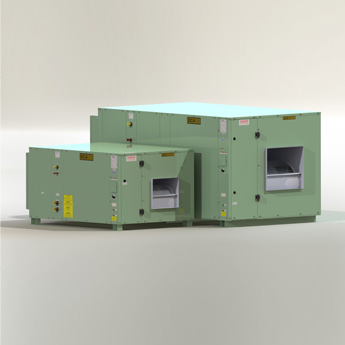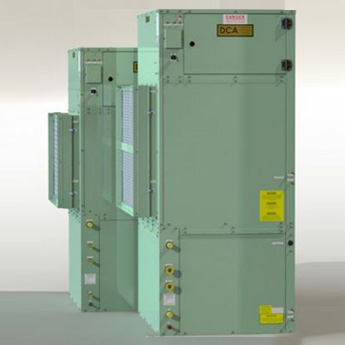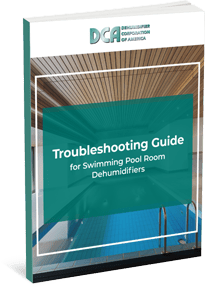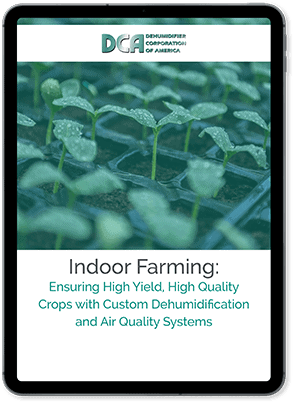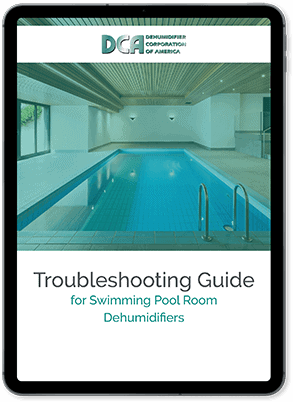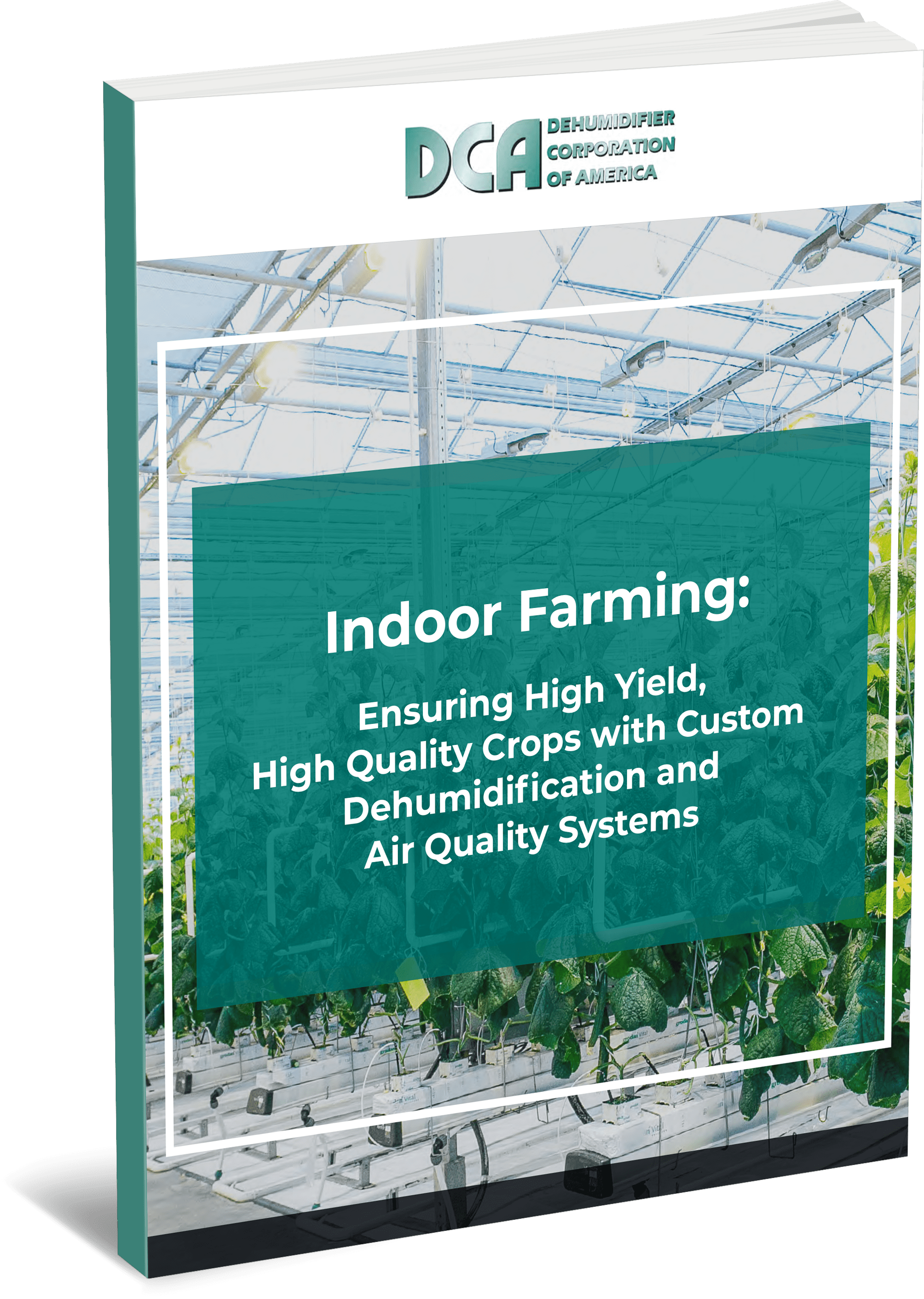Indoor grow houses have grown in popularity as more and more farmers have begun to realize the benefits of growing crops of all types in highly controlled environments. Also referred to as closed growing environments, these spaces allow users to achieve and maintain precise temperatures, humidity levels, carbon dioxide levels, etc., to create the highest-yield, highest-quality crops possible providing “Mother Nature’s Best Day” every day.

Since these spaces are designed as microclimates and have many systems operating to meet water, light, and air needs, they need large-scale, custom-tailored dehumidification systems to ensure the right balance of environmental conditions. These systems are designed to tend to crops’ cycle and growing needs with different modes to mimic day/night and other changes throughout every phase of the plant’s development. This technology ensures that crops can thrive in indoor environments in the same way they do in their rightful outdoor environments.
If you want to learn more about grow room dehumidifiers, ask the experts at Dehumidifier Corporation of America (DCA). DCA engineers have extensive experience providing dehumidification solutions to commercial growers for their indoor grow facilities. Whether you need horizontal or vertical configurations and indoor or outdoor installations, we can design, build, and integrate a dehumidification system that supports your indoor growing operations.
Indoor Grow Room Dehumidification 101
Indoor grow rooms require a full seal to ensure the recirculating air maintains the right conditions for optimal crop growth. One of the key controlled parameters is humidity, which, in the proper levels, is essential to achieving higher quality crops in greater quantities. Both too little and too much humidity can diminish the health and quality of crops. For example, overly dry air can lead to poor crop growth and leaf development, while overly wet air can lead to mold, rot, and mildew development and building maintenance problems. Growers use both dehumidifiers and humidifiers to provide the correct room relative humidity for every stage of the plant’s development.
Why Are Dehumidifiers Important for Indoor Grow Rooms?
Dehumidifiers are engineered to draw moisture from the air when it exceeds a set range. The upper and lower limits generally depend on the current growth stage of the crops. Seedling and clones require humidity levels of 70–75%, vegging plants require humidity levels of 50–70%, and flowering plants require humidity levels of 40–50%. Properly sized and configured, a dehumidifier is an effective and efficient solution for reducing humidity levels within grow rooms when needed.
How Do I Determine the Ideal Dehumidifier Size for My Grow Room?
Dehumidifiers are rated (i.e., sized) based on their total moisture removal capacity, which is typically indicated in pounds of moisture removed per-hour period (e.g., a 25-pound model can remove 25 pounds of moisture per hour at a specific room condition). The dehumidifier size needed for a particular grow room depends on its dehumidification needs. There are many factors that influence this value, such as, but not limited to:
- The types and number of plants
- The planting method
- The watering and irrigation methods
- The amount of water given to each plant each day
- The utilization in conjunction of a present HVAC system
- The use of CO2
- The number of windows/doors
- The external environment conditions
- Whether outdoor air will be introduced into the room
- The construction of the grow room itself and room vapor barrier
The following equation can provide an estimate of your dehumidification needs expressed in pounds per hour, at a specific room air temperature, to be removed:
[Number of plants] X [gallons of water per plant per day] X 8 (conversion factor for gallons-to-pounds) = [recommended dehumidifier capacity]
You should choose a dehumidifier with a capacity that meets or exceeds this number. However, consider this product a starting point rather than a hard-and-fast rule. Other factors to consider include:
- How many doors and windows does your grow room have? Does it have a vapor barrier in the walls & ceilings? Is the room construction considered loose or tight?
- The number of workers working the room and their type of activity.
- The amount of time doors and windows are open during a 24-hour period.
- Are there any unusual features of the grow room not covered in the above?
It’s also important to note that using a ventilation system in a naturally humid environment must be calculated separately for the geographic area. Many times, it makes sense to engage an engineering company to determine the specific moisture load for your project.
Request A Free Project Analysis
Get the Proper Indoor Grow Room Dehumidifier With DCA
Dehumidifier Corporation of America has long understood the importance of indoor air quality and constantly strives to provide equipment for proper ventilation, exhaust, monitoring, and more. We offer dehumidifiers in a variety of designs and configurations to suit grow rooms of all sizes.
Indoor Grow Room Dehumidifier Options
- Horizontal or vertical configuration accommodating the specific installation requirement
- Indoor or outdoor installation (horizontal only)
- Rooftop curb mounted
- Water source cooling
- Outdoor remote condenser cooling
- Introduction of outdoor make up-air
- Many more options available (consult factory)
We know the variables that go into maintaining proper indoor growing conditions, which enables us to design systems for maximum efficiency in commercial cannabis and vegetable growth operations. We can help to maximize indoor growing efforts by assisting with:
- Humidity control
- System design
- Seamless system integration to existing systems and structures
- Product quality control
- Trouble-free automatic operation and remote controlling systems
- Comprehensive 3-year warranty on all dehumidifiers and remote condensers
Choosing the Best Grow Room Dehumidifier for Your Needs
There is no one-size-fits-all solution when it comes to dehumidification. The best dehumidifier depends on the grow room; different growing operations need different units. Some of our top-performing models are DCA2000A/DCA2000T, DCA3000A/DCA3000T and DCA3600A/DCA3600T.

In addition to these standard dehumidification units, we can design, build, and install custom systems tailored to the needs of the customer. We can completely and seamlessly integrate the system into existing systems with both new and existing structures.
Browse Our
Dehumidifier Catalog
Contact the Experts at DCA for More Info on Dehumidifier Solutions
Choosing the right dehumidifier goes beyond capacity and configuration. Equally important is working with a reputable supplier who understands the demands of indoor growing. Dehumidifier Corporation of America has years of experience in the indoor grow house industry and has helped many commercial growers maximize their yield across industries and crop types. This expertise in system design and integration makes us an ideal partner for professional growers.
To learn more about our dehumidifier offerings and how we can benefit your growing operations, contact us or request a quote today.


